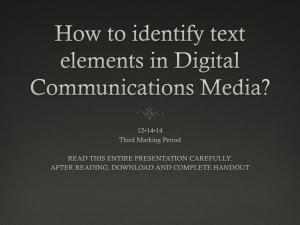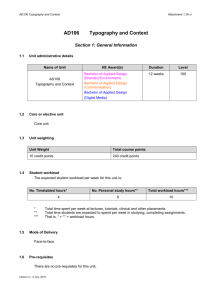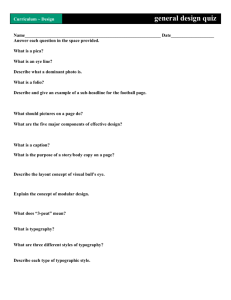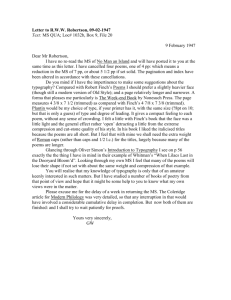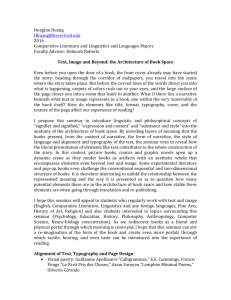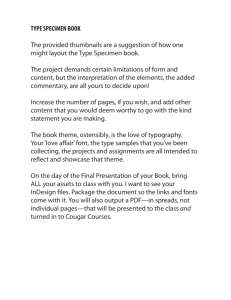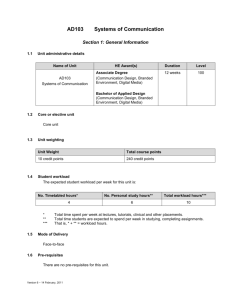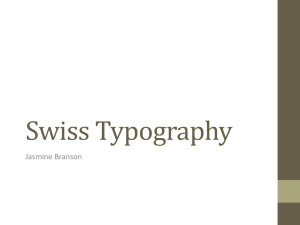IDC, IIT Bombay - Typography Day 2016
advertisement
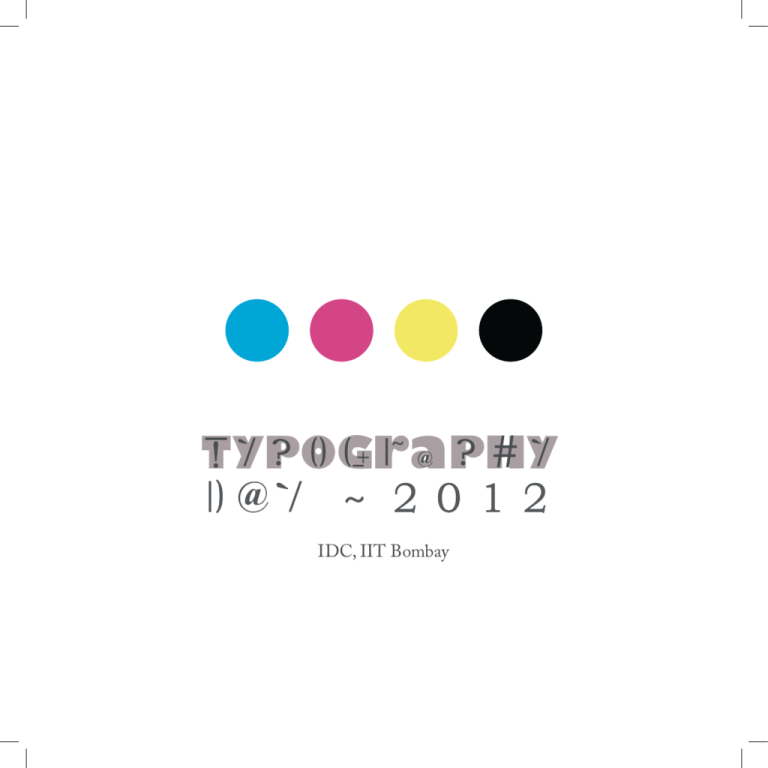
IDC, IIT Bombay ii INTRODUCTION Typography Day 2012 Typography Day is being held for the fifth time in 2012 (1st-3rd March) at the Industrial Design Centre (IDC) at the Indian Institute of Technology Bombay (IIT Bombay) with support from India Design Association (InDeAs) and Aksharaya. The event includes workshops on Typography, a meet on discussing research on typography and an international conference devoted to addressing issues faced by type designers, type users and type educators. The theme for this year’s event is ‘Typography in Publication Design’. Exhibitions on Typography Posters and Book Publications will also be hosted. The event is planned over three days: Day 1: Workshops on Typography + Meet on ‘Research in Typography’ Day 2-3 : Conference focusing on ‘Typography in Publication Design’ Day 1: Workshops on Typography: Typography workshop is designed to offer exposure to student community on various aspects of typography in Multi language scripts with a focus on Publication Design. This will provide a platform for students from varied backgrounds to interact with practicing professionals in graphic design. Meet on Research in Typography: This meet of participants interested in research in typography is expected to bring focus on areas for investigation as well as forming of a community to interact and exchange ideas on research in this field. Day 2-3: Conference focusing on ‘Typography and Publication’ : The Conference will focus on the following issues: • Experiments and Explorations in Publication Design. • Publication Design with multilingual scripts. • Typography and Publication Design in native (indigenous) Scripts. • Typography and Publication Design within local contexts. • Research activities in Typography and Publication Design. Typography Day 2013 The next typography day is being held at the Indian Institute of Technology Guwahati. The theme for this conference is ‘Typeout – Outdoor Typography’. 5 Industrial Design Centre (IDC) 6 Industrial Design Centre (IDC) at the Indian Institute of Technology (IIT Bombay) offers an excellent environment for academics, research and applications in the field of design. IDC has academic programs in the areas of Industrial Design, Visual Communication, Interaction Design, Animation and Mobility & Vehicle Design. The education Programme at IDC is a unique mix of pedagogic experimentation with pragmatic design approach and blends hard-core problem solving with design research. New thoughts, philosophies and research into several aspects of design are experimented and integrated to have continuous revitalization of the academic programmes at IDC. Several areas have been identified for research. Faculty members along with students and other research and design staff work together on these issues. The centre interacts with industries and institutions for promotion and awareness of design. These are in the form of organizing seminars, conducting short term courses and workshops. In the area of design practice, IDC offers professional design consultancy and advisory services to industries and other organizations. Design education at IDC The prime objective at the IDC is an integrated and interdisciplinary approach in design education. The design training at the IDC is intended to develop an attitude among the students toward problem solving in design in order to prepare them to go into the field and face a wide range of challenges at the end of their education at the centre. www.idc.iitb.ac.in InDeAs InDeAs is an association for addressing the interests of the design community in India. InDeAs is a pan-India networking, showcasing and events platform for India’s design community (drawn from across the spectrum). The Association will promote and create awareness about the design profession in the country. The design association is named as ‘India Design Association - InDeAs’. www.ideas.org Design in India Designinindia.net is an open source free and resourceful service on the net, providing resource on the world of design in India. The different resources available on the webspace include design disciplines, events, institutions, fi rms, projects, resources, people and thoughts. www.designinindia.net Ligature Club, IDC, IIT Bombay Ligature club attempts to bring together Typographers, Type designers and Type enthusiasts to discuss various aspects about Typography, Type design case studies etc. Ligature Club will organize talks, workshops and awareness programmes for Type enthusiasts, Researchers and Designers to bridge the gap between typography and the common man. It also encourages designers to undertake projects on Indian language typography. www.facebook.com/LigatureClubIndia Aksharaya, Letter Conscious People Aksharaya is an ode to Indian letterforms by a group of letter conscious people. It is an organization of designers, educators, researchers and students, who are driven by a passion for Indian scripts, calligraphy and typography.Aksharaya aims to support languages and scripts through the three E’s: • Expand - promote ‘letter’ as a concept in its various forms. • Educate - create awareness amongst people, both professionals and students, giving them opportunities learn and appreciate Indian letterforms through various activities such as camps and workshops. • Explore - facilitate research and development of Indian script, calligraphy and typography. www.akshraya.org 7 ee SCHEDULE~DAY 1 1st March 2012: Workshops 08:30 – 09:30 09:30 – 09:45 10:00 – 05:00 Registration Welcome and lighting the Diya Workshops for Design Students * these workshops require the use of laptop Track 1 Calligraphy and Publication Design Achyut Palav, Achyut Palav School of Calligraphy, Navi Mumbai Track 2 Book Making Aditi Babel, Independent Book Designer, Jaipur Track 3 Bilingual Typography as a Marketing Tool Prof. Iko Avital, IIT Guwahati Track 4 Edutainment: Letterform Play Prof. Noni Avital, IIT Guwahati Track 5 Font Design in Indian Languages* Manoj Gopinath, C DAC, Pune, Mumbai Track 6 Experiments with Letterforms in 3D* Sarang Kulkarni, WhiteCrow Design, Mumbai Track 7 Generation of new visual concepts in Type Designing through Calligraphy Prof. Santosh Khirsagar, Sir J.J. Institute of Applied Arts Track 8 Publication design and Typography Prof. G.V. Sreekumar, IDC IIT Bombay and Dr. Girish Dalvi, Yahoo India Track 9 Calendar Design Tarun Deep Girdher and Immanuel Suresh, NID, India Track 10 Make Your First Font – getting started in Digital typography* Ted Harisson, President, FontLab Track 11 Magazine Design* Prof. Uday Kumar, IIT Guwahati and Nirmal Biswas, Independent Designer 01:00 – 02:30 Lunch 05:00 – 07:30 Meet on Research in Typography for Research Scholars • 5.00pm: Inauguration of ‘Ligature Club’ • 5.15–6.00: Presentations on ‘Typographic Research’ by research scholars • 6.00–7.30: Group Discussions on Future Directions for Research in Typography 9 SCHEDULE~DAY 2 2nd March 2012: Seminars – Morning Session 08:30 – 09:00 09:00 – 09:15 09:15 – 10:00 Keynote Address 1 – Prof. R. K. Joshi Memorial Lecture 10:00 – 10:30 Vision & the Visual, Ken Botnick, Professor of Art, Director Kranzberg Book Studio, Washington University, USA Tea and Networking Session 1: Typography & Type Design 11.40 – 11.55 Session Chairman: Prof. Mahendra Patel, Emeritus Professor, NID Challenges in multilingual type design David Brezina, Rosetta Type Foundry, UK Designing a Devanagari text font for newspaper use Yashodeep Gholap, Mumbai Developing fonts for Indian scripts Paul D. Hunt, Adobe, USA Discussion & QA Session 2: Typography & Expression 10.30 – 10.50 10.55 – 11.15 10 Tea and Registration Welcome Address by Prof Ravi Poovaiah and Prof G V Sreekumar, IDC IIT Bombay 11.20 – 11.40 12.45 – 01.00 Session Chairman: Prof. Sudhakar Nadkarni, Dean, Wellingkar Institute of Management, Mumbai Innovative applications of Typography–Ancient African Typographic Symbols in Contemporary Publication Design Sophia Oduol, University of Creative Technology, Lesotho Devnagari-Latin ambigrams Pallavi Sudhanshu Apte, India Discussion & QA 01:00 – 02:30 Lunch 12.00 – 12.20 12.25 – 12.45 SCHEDULE~DAY 2 2nd March 2012: Seminars – Afternoon Session 02:30 – 03:15 Vision Address Challenges faced in designing low-cost publications for the bottom of the pyramid, mostly in the local scripts. Tarun Deep Girdher, Associate Senior Faculty, Graphic Design, NID, India Session 3: Typography & Identity 4:15 – 04:30 4:30 – 05:00 Session Chairman: Sudharshan Dheer, Graphic Communication Concepts, Mumbai Investigating Handwriting practice in manuals in current scenario Prof. Santosh Kshirsagar, Sir J.J. Insititute of Applied Arts, India Typocraft: Creating an Indian Typographic Identity Ishan Khosla, Ishan Khosla Design, New Delhi Typography as a Graphic Design within Official (Governmental) Valuables – Case Study of the Botswana’s new set of Bank-notes Zoran Markovic, University of Botswana, Gaborone, Botswana Discussion & QA Tea and networking Session 4: Typography & Type Design 3:15 – 03:35 3:35 – 03:55 3:55 – 04:15 6:00 – 06:15 Session Chairman: Prof. Iko Avital, Professor, Department of Design, IIT Guwahati Ariyaka, the early typeface leads modern industrialization of letterpress printing in Thailand Chitchai Kuandachakupt, Ph.D. Researcher, Kyoto Institute of Technology, Japan Usage of Nasta’liq in the Modern Publications Farzan Kermaninejad, Ph.D. Researcher, Industrial Design Centre, IIT Bombay The experience expansion of typography utilizing the five senses Hoonsik Yoo, Ph.D. Researcher, Interaction Design Lab, Graduate School of Techno Design, Seoul, Korea Making publication grids flexible Prasad Bokil, Ph.D. Researcher, Industrial Design Centre, IIT Bombay Discussion & QA Session 5: Industry Session 5.00 – 05:15 5:15 – 05:30 5:30 – 05:45 5:45 – 06:00 6.16 – 06:45 Using mark-to-mark in the construction of Indic Fonts Adam Twardoch, Fontlab, USA – A presentation by Font Lab 11 SCHEDULE~DAY 3 3rd March 2012: Seminars – Morning Session 08:30 – 09:15 09:15 – 10:00 Tea 10:00 – 10:30 Tea & Networking Session 6: Typography & Book Design Keynote Address 2: The Weekly News Magazine; Dressing up a Dog’s Dinner Bishwadeep Moitra, Executive Editor, Outlook, Delhi 11.30 – 11.45 Session Chairman: Prof. Vikas Satwalekar, Emeritus Professor and Ex-Director, NID Book Design – the showcase field in the visual communication. An international review Uta Schneider, Stiftung Buchkunst, Frankfurt, Germany Teaching Maya to the Next Generation: children’s publication design in a multilingual context Denielle Emans, Zayed university, Dubai, United Arab Emirates Picturing words: expressive typography & story-telling in picture books Rathna Ramanathan, Central Saint Martins College of Art and Design, London, UK Discussion & QA Session 7: Typography & Local Scripts 10.30 – 10.50 10.50 – 11.10 11.10 – 11.30 12 12.45 – 1.00 Session Chairman: Prof. Ranjana Dani, MEER’s MIT Institute of Design, Pune Abilities Of Persian Typefaces & Persian Calligraphy In Stencil Type Design Mahmood MazaheriTari, Tehran, Iran Tending to the Inheritance of Tulu Script Vaishnavi Murthy, Bangalore The use of eye-tracker technology to evaluate typefaces, greek fonts and publication design for screen Evripides Zantides, Cyprus University of Technology, Cyprus Discussion & QA 01:00 – 02:30 Lunch 11.45 – 12.05 12.05 – 12.25 12.25 – 12.45 SCHEDULE~DAY 3 3rd March 2012: Seminars – Afternoon Session Session 8: 2.30 – 2:50 2:50 – 3.10 3:10 – 3.45 Design Projects Session Chairman: Professor Suresh Immanuel, Faculty, NID ONOMATOPOIEA With the comics Khushbu shashikant sangoi, Sir J.J. Institute of Applied Arts, Mumbai My experiments with Type: Devanagari typeface design at Linotype Kimya Gandhi, Alumnus, IDC, IIT Bombay Typeface Design Anukriti Verma, M Des VC student, IDC, IIT Bombay Aman Rupesh Xaxa, M Des VC student, IDC, IIT Bombay 3.45 – 4.00 Session 9: 4:30 – 4:50 4:50 – 5.10 5.10 – 5.30 5.30 – 5.45 Session 10: 5.45 – 6.00 Discussion & QA 4.00 – 4.30 Tea and Networking Typography & Culture Session Chairman: Dr. Ajanta Sen, Director, Solar Project, India Notes for studies on Typography and Publication Design in indigenous (native) languages of Brazil Kollontai Cossich Diniz, University of Sao Paulo, Sao Paulo, Brazilw The Craft of Bookmaking Aditi Babel, Independent Book Designer, Jaipur Typographic Culture of Hong Kong Mariko Takagi, Hong Kong Baptist University, Kowloon, Hong Kong Discussion & QA Closing Session Awards + Concluding Remarks 13 ss ss s s SPEAKERS Keynote Speakers Ken Botnick, Bishwadeep Moitra, Vision & the Visual The Weekly News Magazine; Dressing up a Dog’s Dinner Professor of Art, Washington University, Prague Abstract This paper examines current research in visual cognition and is formulated around four fundamental questions: what is the role of visual cognition in the perception of visual design; how does it shape its making; should design education include a component on cognition; is there a role for graphic designers to play in scientific investigation. I will discuss insights gained from my work with design students and collaboration with colleagues in cognitive psychology, and the curriculum in visual cognition that has resulted. The paper also raises questions about the implications of such a curriculum for the future of design practice as we struggle to address the needs of diverse populations of users of visual design. Keywords: Visual Cognition, Design Education, Visual Design Executive Editor, Outlook, Delhi Abstract The design mantra we gave ourselves at Outlook was: Simplicity is the ultimate sophistication. Simplicity of the design should be linked to making the magazine easy to read. The main thing about editorial design is that it should make things intuitively obvious. We employed minimalism but we avoided minimalism to make the magazine look cold. In the design room we were passionate and super serious about design but at the same time the designs we created had a sense of play. Design is the frame that holds a magazine together, it’s the subtle yet vital component that distinguishes one magazine from the other. Without design, a magazine is merely a melange of disparate elements; with it, it is a disciplined entity. We wanted a design that would be simple but expressive in spirit. The job on my hand was to create a design structure for the magazine that addressed to three different groups. The User, the consumer, and the advertiser. Keywords: Magazine Design, Outlook India 15 Vision Address Tarun Deep Girdher, Associate Sr. Faculty, Graphic Design Head, Printing Labs Designing Low Cost Publications for Bottom of the Pyramid – Challenges and Concerns 16 Abstract How do we judge a good publication design? The content of course, the overall layout of the text, the nature images – illustrations and photographs, which appeal to our aesthetic sensibilities even more, with good quality printing on impressive glamorous paper. All this comes at a cost. Price of the publication often defines it’s reach and accessibility, especially publications in regional languages which are produced in smaller numbers. Taking the example of school textbooks in India, which have a high penetration, often the lowest bidder produces the books. Assuming this as a limitation, is it possible to design publications which still appeal to the aesthetic sensibilities of the readers, are affordable and readable? This presentation shares a few case studies in which the limitation of producing a low cost publication was converted into an advantage. It presents the challenges and concerns faced while designing publications in regional languages, with limited variables in creating typographic hierarchy, especially while designing for single colour print production. Keywords: Publication design, low cost print production, typography, accessibility, typographic hierarchy International speakers David Brezina Denielle Emans Challenges in multilingual type design Teaching Maya to the Next Generation: children’s publication design in a multilingual context Rosetta Type Foundry, UK Abstract When designing multilingual type families, designers face challenges on the crossroads of linguistics, typography, and computer science. Type design is not only drawing nice lettershapes, it also deals with their optimisation for output, that is, with typographic layout, and demands of target media. Some of the challenges lie in extending the typographic repertoire of one script (i.e. writing system) with tools similar to those of another. Other challenges lie in adapting the scripts to typographic system or to the limitations of certain kind of media. The central question behind new typefaces should be: How can we improve the contemporary typographic tools in a respectful and meaningful way so designers tomorrow can communicate better than we could? Standing on the shoulders of giants, type designers are trying to extend the possibilities of the typography of world scripts today. Keywords: Multi-script, world script, typography, type design, Arabic, Armenian, Cyrillic, Devanagari, Gujarati, Bengali, Oriya, Malayalam. Zayed university, Dubai, United Arab Emirates Abstract This research paper discusses the cultural perception, value, and need for indigenous language preservation and underscores the importance of multilingual publications that enhance mother-tongue learning initiatives. The paper is presented and contextualized for the needs of Mayan children in the Yucatan Peninsula where publications that meet both multilingual and multicultural standards are rare at best. Following an introduction to the case study of the multilingual book “Have You Seen a Melipona Bee,” the findings offer guidelines for designing multilingual children’s publications and promote the strategic value of design to aid language conservation efforts. Keywords: Multilingual Design, Typography, Yucatec Maya, Children’s Publication Design, Mother-tongue learning, Design Anthropology 17 Evripides Zantides Mahmood MazaheriTari, The use of eye-tracker technology to evaluate typefaces, greek fonts and publication design for screen Abilities Of Persian Typefaces & Persian Calligraphy In Stencil Type Design Cyprus University of Technology, Cyprus 18 Abstract The aim of this paper is to present how the technology of eye-tracker can be used to research typography and publication design for screen applications. Various studies have already been done on the ways that the eyes pause—and for how long on words—nonetheless using an eye-tracker to explore the role of letterform characteristics on screen still encourages further investigation, especially for fonts in Greek, where similar evaluation research was not found. The present study sets two major screen-based typefaces, Verdana and Georgia in Greek, and examines as well as it compares reading-speed and viewers’ preferences between the two. Using a within-subjects design, data were collected from 28 participants who read sentences and paragraphs set in different typographic parameters. Significant speed differences were found for lower-case paragraph-texts set in Georgia and upper-case single line sentences set in Verdana. The experiment provides a platform for further research by incorporating additional typographic and demographic variables to investigate. Keywords: Eye-tracking, Typography, Greek typefaces, Publication design for screen. Tehran, Iran Abstract Stencil as an ancient technique in type and image publication has a remarkable use in Iran and has a dialectical affect in Persian type as it is used in other cultures. This research is presented in 2 sections. Each section starts by a principal question and had been tried to ask it subsequently. First section Regards abilities of Persian alphabet form, reed pen usage in different calligraphy styles and geometric forms in Persian decorative scripts. (Especially in Square Kufic). All found and obtained results, have been examined, and have been visualized in a new stencil type as a practical project. The second section examines the abilities of stenciling to prevail over Persian alphabet’s difficulties in typesetting. Keywords: Stencil, Type Design, Persian Calligraphy, Ornamental Scripts, geometric type, Square Kufic Mariko Takagi Hong Kong Baptist University, Kowloon, Hong Kong Typographic Culture of Hong Kong Abstract Does a special and unique typographic culture exists in Hong Kong? And if yes, how is the Hong Kong typographic culture distinguishable from other Asian cultures as China, Japan, Korea, Taiwan, etc.? Who are the leading typographers and what are their missions? How to promote and develop the “typographic culture of Hong Kong” in future not only within the local context, but internationally? This research on “typographic culture in Hong Kong” does not only aim to analyse the current situation but shows ways of creating awareness of the Hong Kong typographic identity and culture in the future. The long-term significance of this project is to promote the international acceptance of Hong Kong (designer/artist) in the field of graphic design and typography in particular. Keywords: Hong Kong, Typography, Chinese complex characters, typographic design, visual culture, phenomenology Rathna Ramanathan Central Saint Martins College of Art and Design, London, UK Picturing words: expressive typography &story-telling in picture books Developing fonts for Indian scripts Abstract This talk discusses the use of typography as both word and image to tell a story. Using case studies from historical world graphic design as well as specific examples from Tara Books, India’s wellknown experimental and avant-garde publisher, the talk explores how expressive type through associations can convey sound, texture, movement, colour, atmosphere and even emotion. Expressive typography can allow children (and adults) to discover unexpected meanings and associations in language. The talk challenges traditional notions of legibility and readability. While traditional books are created with linear story telling, expressive type can allow us to explore the page spatially, leading to new relationships between reader and object. This talk uses historical examples from modernist graphic design as well as three contemporary Indian picture books – Anything but a Grabooberry, Tiger on a Tree and In the Land of Punctuation - to make its case. Keywords: Type play, expressive typography, picture books, publishing 19 Sophia Oduol, Uta Schneider, Innovative applications of Typography Ancient African Typographic Symbols in Contemporary Publication Design Book Design – the showcase field in visual communication. An international review Abstract This paper aims to explore how the Ancient African iconology has been reborn in to contemporary typography and is used in today’s publishing. The study is placed in the context of the history, meaning, deciphering and transformation of Typography. A conceptual framework is constructed, based on critical theory from arts disciplines, notably from the history of African Iconography from the Igbos and the Adinkra. This paper also finds that typography has now transformed into informal, colloquial icons, where everyday published communiqué can occur through signs rather than speaking. These signs are conclusively a replica of ancient African symbols. The visual framework reveals a changing iconology where symbols may be discerned. Abstract The principles governing the medium “book design” are universal. Despite similarities and differences within national design traditions based on culture, ways of “thinking book” with regard to the design process are comparable the world over. The book designer is translator, visual author, dramatic advisor and stage director all in one. Book design is a complex affair. With its diverse conceptional and graphic design approaches it represents the supreme discipline within the realm of typographical design. Keywords: Typography, Iconology, Ancient African Symbols, Deciphering and Transformation Developing fonts for Indian scripts University of Creative Technology, Lesotho 20 Stiftung Buchkunst, Frankfurt, Germany Keywords: Book design, graphical concept, structure of content, book features, three-dimensional object, structure of binding, the designer as visual author, international comparison Paul D. Hunt, Adobe, USA Abstract In this paper I will outline the current options for typesetting Indian scripts in Adobe’s popular Creative Suite applications. Keywords: Typography, digital typesetting, software, Indian scripts, Indian languages, Unicode, fonts, Adobe Creative Suite, instructions. National speakers Zoran Markovic, Ishan Khosla, Typography as a Graphic Design within Official (Governmental) Valuables – Case Study of the Botswana’s new set of Bank-notes Typocraft: Creating an Indian Typographic Identity University of Botswana, Gaborone, Botswana Abstract The paper takes a closer look at the relationship between tradition and modernity in the present context of commercial transformation of Indian visual culture. Tradition gives an insight to examine the past that contributed to the present, and how it affects future developments. At times, India has shown cultural divide between those who saw tradition as a bastion of resistance and those who saw it as an impediment to modernizing Indian culture. The open market economic policy during the 1990s was one such occasion that witnessed people of both beliefs. How can designers work with tradition? Is tradition = freedom or tradition = limitation? Do we need to have continuity with the past at all when the future is fiercely moving ahead? How does the visual media approach the cultural limitations and aspirations? Keywords: Tradition, Modernity, Indian culture Ishan Khosla Design, New Delhi Abstract Typography and graphic design in India, today, is very west-focussed. This means, unlike countries such as Holland or Japan, we in India don’t really have our own unique typographic language. The motivation for this on-going project is to change that and make our typography and design more “Indian”. Craft is one avenue to connect with our ancestry and our traditional visual language which was rooted in “India”. Combining design with craft can make typography come alive with both meaning and form. It is uniquely Indian and yet speaks to a global world. Keywords: Typography, craft, design, typecraft, art, tribal, traditional, visual culture, tradition, handmade, pigment, embroidery, textile, heritage, contemporary, India, Indian Graphic Language, graphic design 21 Pallavi Sudhanshu Apte, Vaishnavi Murthy, Devnagari-Latin ambigrams Tending to the Inheritance of Tulu Script India Abstract The core content of this paper is bi-lingual bi-scriptural ambigrams in Devnagari and Latin scripts. Through these ambigram artworks and detailed demonstration of their creation process, the paper intends to establish ambigrams in the Indian scenario and thereby create overall awareness about the concept. Keywords: Ambigram, Devnagari-Latin combination, bi-lingual, bi-scriptural, inversion, flip script, vertical palindrome Yashodeep Gholap, 22 Mumbai Designing a Devanagari text font for newspaper use Abstract In this paper, we describe a methodology used to design a new Devanāgarī typeface for newspaper use. The main aim of this exercise was to find a balance between aesthetic and functional requirements of newspaper text typefaces. It was designed intentionally for Hindi, Marathi and basic Sanskrit. This typeface has been made functional keeping in mind today’s requirement of economic printing and online usage of newspaper. Keywords: Comparative study of Newspaper fonts, Devanagiri typefaces, Type design, Legibility, Economy Bengaluru Abstract Tulu is a language from South India that had a script of its own. This script over time disappeared due to the introduction of Kannada printing presses. Tulu which was largely an oral language has seen two renaissances where many literary works have been emerged and is today as much a written language as spoken one. In this context, there is scope for reviving the old Tulu script by rendering it with appropriate technologies that make it easy to use. This paper describes the project to standardize the Tulu script and consequently translate it into a usable typeface. It discusses the need for bringing back the Tulu script and the steps that need to be taken in order to employ the script at various levels. Keywords: Indic Script Standardization, Tulu Script, Tulu Font, Tulu Typeface, Indic script, Indic Typeface, Proto South Dravidian Language, Minority Language, Tulu Lipi. Doctoral speakers Chitchai Kuandachakupt, Farzan Kermaninejad, Ariyaka, the early typeface leads modern industrialization of letterpress printing in Thailand Usage of Nasta’liq in the Modern Publications Ph.D. Researcher, Kyoto Institute of Technology, Japan Abstract The pioneer of Ariyaka, known as an Aryan language, and Ariyaka typeface had benefited the development of mass media production in graphic design such as newspapers, political posters and several official regulations. People were educated and they started to learn modern technology from then on. This research focuses on the aspects of typesetting and the shapes of Ariyaka typeface compared with the original Latin typeface (Roman alphabets). During the history of printing in Thailand, Ariyaka Typeface has been used in a minority and limited parts only in area of Buddhism studies, but the creation of typographic form is very outstanding. Ariyaka typeface reveals some potentials of using in visual communication and graphic design and it may give some interesting results in the process of experimental works and future suggestions. Keywords: Thai, Typography, Ariyaka. Ph.D. Researcher, Industrail Design Centre, IIT Bombay Abstract Nasta’liq is a beautiful calligraphic and most widely used style of writing Farsi (Persian)/Urdu using an adapted Arabic script that has 36 and in Urdu 39 characters as against 28 in Arabic. In Nasta’liq, many character shapes have multiple instances. The shapes are context-sensitive too – character shapes changing with changes in the preceding character or the succeeding one. At times even the 3rd, 4th or 5th character may cause a similar change. Farsi/Urdu typography has been a great challenge for the printing and publishing industry. Because it is composed of complex and shifting letters, typesetting technology, based on separate letter. In addition of illustrating the history of Nasta’liq printing, this paper discusses the complexity of Nasta’liq and experiments the usage of Nasta’liq in modern publishing requirements. And it tries to portrait the different efforts made in different countries. Keywords: Nasta’liq Font, Cursiveness , Ligature, Farsi typography, Urdu typography, Farsi DTP, Urdu DTPcontemporary, India, Indian Graphic Language, graphic design 23 Hoonsik Yoo, Prasad Bokil, The experience expansion of typography utilizing the five senses Making publication grids flexible Ph.D. Researcher, Interaction Design Lab, Graduate School of Techno Design, Seoul, Korea 24 Abstract Typography is a very old traditional area, but only sense of sight area has been studied until now. But from now on, multidimensional models might be studied and expanded including other four senses of touch, hearing, smell and taste, as well as sense of sight. In addition, technological developments enable us to apply such multidimensional experiences to physical products and publications. This is a research feasibility verification case study, together with theoretical proposal about expansion of typography experiences, and we exhibited this “Expansion of Typography experiences using five senses”. Core significance of this paper is a proposal of expansion of typography experiences and detailed researches for each five senses are required for future study verification and developments. Keywords: Experience Design, Five Senses Ph.D. Researcher, Industrial Design Centre, IIT Bombay Abstract The grid is a well known tool in graphic design, mainly in typography. Being a common tool in practice, it hardly got externalized in terms of knowledge representation. Grid is effective in space management and helps designer in decision making, both visual and managerial type. In spite of these advantages, many students and professionals are skeptic about its use. There is an expressed fear about getting trapped in the grid. This paper will try to understand this tool and will try to externalize the cognitive process of designing layout using grids. With the FBS framework, the behavior variables of grids are defined. These variables are used to propose a method to make layouts flexible. This method is called as Grid Variable Method. The variables of grid and its application in GV method is discussed with various examples in graphic design. Keywords: Grids in graphic design, FBS framework, Grid Variable method, design too Student speakers Khushbu Shashikant Sangoi, Kollontai Cossich Diniz, ONOMATOPOIEA With the comics Notes for studies on typography and publication design in indigenous (native) languages of Brazil Sir J.J. Institute of Applied Arts, Mumbai Abstract After observing various styles of lettering activity used for the onomatopoeia in comic books the task to create such lettering for onomatopoeia in Guajarati language comic books is being concentrated as subject matter of this paper with more concentration on the onomatopoeic characteristic being expressed in the lettering activity for Guajarati comic books was done, English language comic books were matter of reference, with these references of lettering styles of bright colors and bold letter forms . Lettering activity for onomatopoeic words in Guajarati comic books and type design activity was done. Onomatopoeic words were also added as per the demand of situation in these Gujarati comic books strip. Keywords: Onomatopoeia, Comic books, Lettering, Gujarati, Phonemes University of Sao Paulo, Sao Paulo, Brazil Abstract This paper offers a brief overview of the rich multilingual reality of Brazil, and of the history of print of indigenous languages since colonial times. Ten, from an analysis of printed material, key questions for studies on typography and publication design in indigenous Brazilian languages, such as lack of typographic and visual criteria in the creation of new orthographies, and technical and practical problems in the use of special characters are highlighted. As a conclusion, a preliminary set of guidelines to support linguists in the formulation or revision of writing systems for indigenous languages in Brazil is discussed. Keywords: Indigenous languages, typography, teaching material, publication design history 25 Kimya Gandhi, Aditi Babel, My Experiments with Type: Devanagari typeface design at Linotype The Craft of Book Making Alumnus, IDC, IIT Bombay 26 Abstract This presentation is an investigation into the process of designing a Devanagari typeface family which is compliment to an existing sans serif Latin typeface from the Linotype library. The nature of the Latin a typeface made the project both challenging and interesting. Study of the nature of the Latin typeface was a pre requisite to designing the Devanagari. It was important to retain the devanagari-ness even while designing a constructed contemporary typeface. The trick was to not compromise the essence of the script or merely ape design features in the wake of designing a compliment. The attempt has been to retain the character of the script yet maintain an overall design feel of the Latin. Working out proportions of the Devanagari alongside the Latin, scaling, maintaining the overall colour and feel of the typeface were major concerns in the process of designing the typeface family. The talk will delve deeper in understanding design decisions taken while designing a Devanagari typeface complimenting a Latin. Keywords: Devanagārī typeface, Non-Latin type design Alumnus, IDC, IIT Bombay Abstract This presentation will focus on three aspects of Book Making • Traditional art of book binding & artist books • The importance of this craft for a book designer • Artist books created by the author This presentation is a walk through the ancient and neglected craft of book making, its importance and the need of innovation for the survival of this craft. A brief journey of ancient artist books to contemporary artist books with artist names and book images. Keywords: Book Binding, Art Books Anukriti Verma, Aman Rupesh Xaxa, Typeface design –IDC Aadya Typeface Design for Tolong Siki Abstract Right from the morning newspaper to text messages, emails and road signage, we see so much type around us that we stop actually seeing them. This project is an attempt to contribute to the field of Type design in Devnagari. Catering to the current emerging needs of Devnagari fonts, “IDC Aadya” is a contemporary font that can be used for display purpose. The typeface is fresh, youthful and distinctive. The font can be used in magazines, posters, websites, e-Books, etc. Abstract Chotanagpur Plateau is home to 32 indigenous tribes each having their own unique culture, beliefs and dialect. Kuruxars are the third tribe to have developed their own script Tolong Siki. The other two scripts being Warang Chiti for the Hos and 01 Chiki for the Santalis. IDCxaxatolong is the first and only designed Typeface for Tolong Siki. M Des VC Student, IDC, IIT Bombay Keywords: Typeface Devnagari, Display font M Des VC Student, IDC, IIT Bombay Keywords: Typeface, Indic script, Tolong Siki, Kurux 27 cc c c c c POSTER COMPETITION Posters expressing ‘My Favorite Word in My Own Motherscript’ is a tribute to emotions invoked in the use of one’s motherscript, and is a reminder of the power of the single word. An array of such words from different cultures tells us that the ‘local’ in a globalised world is still alive and kicking. These posters are an outcome of a typographic compositions using digitally created calligraphic letterforms, existing fonts or a combination of these, to express a favorite word in one’s own motherscript. Poster Jury Members Prof. Ravi Poovaiah, IDC, IIT Bombay Prof. G.V. Sreekumar, IDC, IIT Bombay Prof. Santosh Kshirsagar, Sir JJ Institute of Applied Arts, Mumbai Dr. Girish Dalvi, Yahoo India, Bangalore Exhibition Thirty Three winning entries are published and displayed in an exhibition during the event. The following are the winners of the poster competition held on the occasion of Typography Day 2012: 1. ‘Akannen’ (No way!) in Japanese by Azumi Nishitani, Kyoto, Japan 2. ‘Alaukika’ (rare) in Devanagari by Apoorv Tomar and Priyanka Parkar, Guwahati, India 3. ‘Analog’ in Roman script by Esteban J. Pérez, New York, USA 4. ‘Agua’ (water) in Portugese by Pedro Miguel da Silva Monteiro, Aveiro, Portugal 5. ‘Awaiting the Gift’ in Persian by Shahin Afshari, Tehran, Iran 6. ‘‘Besmelah’ in Persian by Syed Hashemi J Seyedeh, Iran 7. ‘Besmellah’ in Arabic by Bahram Hamidi, Guilan, Iran 8. ‘Bongo’ (Bauls of Bengal) in Bengali by Mrinalini Sardar, Kolkatta, India 9. ‘Calligraphy’ in Nastaliq by Hamed Hakimi, Tehran, Iran 29 10. ‘Danceisa’ in Arabic using Nastaliq script by Alireza Khakpour, Fars, Iran 22. ‘Love’ in Roman script by Gimminji, Daejeon, S Korea 11. ‘Darkroom’ in Persian Script + ‘Empty’ in Persian by Ardeshir Noshirvanisharifabadi, Tehran, Iran 23. ‘Meshiagare’ (Bon appétit) in Japanese by Eri Nakaoka, Kyoto, Japan 12. ‘Death’ in Nastaliq by Saeed Faraji, Tehran, Iran 13. ‘‘Disleksi’ (dyslexia) in Turkish by Deniz Yeşim Taluğ, Turkey 14. ‘Eshgh’ (Love) in Persian by Mohammad Mahdi Mirzaei, Tehran, Iran 30 15. ‘‘Huinyeoul’ (Crystal Clear Water) in Korean Huiyeoul script by Yea Rim Lee, Daejeon, S. Korea 16. ‘‘God’ in Persian by Nasir Bashiri, Teheran, Iran 17. ‘I am Alone’ in Nastaliq by Ali Emrani, Tehran, Iran 18. ‘Infinity’ in Persian by Mohammad Rafiee Sahlabadi, Iran 19. ‘‘Jjajangmyeon’ (Korean Dish) in Korean by Jeonsaetbyeol, Daejeon, S Korea 20. ‘Kafe Horof ’ (coffee shop of letters) in Persian by Majid Kavianmehr, Sabzevar, Iran 21. ‘Light attic’ in Persian by Ensieh Knjoori, Kermanshah, Iran 24. ‘Michhami dukadam’ in Marwadi, in Devanagari by Yesha Jain, Mumbai, India 25. ‘Peace’ in Arabic script by Rokhsareh Ranjbar, India 26. ‘Pochopení’ (understanding) in Czech by Tomáš Novotný, Borova, Czech Republic 27. ‘Strange’ in Nastaliq script by Davood Khalili, Teheran, Iran 28. ‘Suburbia’ in Roman Script by Clara Eckert-Framm, New York, USA 29. ‘Trapped’ in Farsi by Sina Fakour, Tehran, Iran 30. ‘Tree’ in Persian and Roman script by Hamid Vasfi, Guilan, Iran 31. ‘War for Peace’ in Arabic by Mohsen Abbasghorbani, Iran 32. ‘Waiting’ in line for essentials in Persian by Ali Delzendehrooy, Shiraz, Iran 33. ‘26/11’ in Marathi by Ruchita Naresh Bhoir, Mumbai, India Organizers: Supporting Partners: Sponsors: IDC IIT Bombay Industrial Design Centre IIT Bombay Design in India Font Lab In collaboration with: Adobe India Design Association Aksharaya Letter Conscious People Ligature Club IDC, IIT Bombay D’ Source 31 CREDITS Core Team Prof. Ravi Poovaiah Prof. G.V. Sreekumar Dr. Ajanta Sen Prof. Santosh Kshirsagar Dr. Girish Dalvi Student Coordinators Nanki Nath Neha Jain Sanjukta Das 32 Advisors Prof. Mahendra Patel Sri Sudarshan Dheer Prof. Ravi Poovaiah Sri Achyut Palav Prof. G.V. Sreekumar Dr. Ajanta Sen Prof. Tarun Deep Girdher Prof. Immanuel Suresh Prof. Santosh Khirsagar Prof. Ranjana Dani Dr. Uday Kumar Dr. Girish Dalvi Project Staff Roop Sahoo Chetan Bhuj Samarth Wankhede Shrikant Das Sumedh Garud Santosh Sonawane Sachin Pagare Shiddesh Sawants Sanmati Hosuru Sunita Rajput Shaili Chandorkar Trupti Ekmalli P.S. Patekar Rudra Paul Rahul Gaikwad Patekar P. S. Khairnar N. B. Kini D. K. Mohan Kumar Upadhyay B. B. Krutika Gulhane Konark Ashara Prandeep Gyan Vir Reagan Raj Rumin Halarnkar Shishir Bhagde Omkar Waghmare Anukriti Verma Sukriti Nigam Support Staff Nancy F. Anupama S Mohan Kumar Vinay Adhikari M.S. Ranjan K. A. Patil P.T. George D.K. Kini S.V. Patil R. B. Khairnar M. M. Prajapati A. G. Sawant B. M. Divekar B.B. Upadhayay N. G. Navle A.V. Mawade N.B. Khairnar A. V. Desai S. B. Shelar N.H. Warghade Student Volunteers Neha Jain Aman Rupesh Xaxa Shravan Muralidhar Ami Shah Puja Vanarse Jyothi Akula Ibynta Tieswoh Aditi Kulkarni Mugdha Kale Priyanka Chavan Shubhangi Jadhav Deepali Karanjavekar Narendra Singh Sanjukta Das Surbhi Bindlish Prasad Bokil Akshata Prabhu Chirayu S. Shinde James Chandrakesh Krishand R.K. Editors Prof. Ravi Poovaiah Prof. G.V. Sreekumar Brochure Design Prof. G.V. Sreekumar Nanki Nath Logo: Typography Day 2012 Nilam Bhande, B.F.A–3rd year, Sir J.J. Institute of Applied Arts SPONSORSHIPS Whether it’s a smartphone or tablet app, a game, a video, a digital magazine, a website, or an online experience, chances are that it was touched by Adobe technology. Our tools and services enable our customers to create groundbreaking digital content, deploy it across media and devices, and then continually measure and optimize it based on user data. By providing complete solutions that combine digital media creation with data-driven marketing, we help businesses improve their communications, strengthen their brands, and ultimately achieve greater business success. Create a font with Fontlab Font Software. Fontlab is the world leader in font software. Companies like Microsoft, Apple, Adobe, IBM, Linotype, and many others use Fontlab software to create and edit fonts. Our font editor tools let you do almost anything that is possible to do with a font. From TypeTool, our basic font editor, to Fontlab Studio, used by professional type designers around the world, to AsiaFont Studio, the worldwide font creator, Fontlab has a font editor product that suits your needs. 33 36
